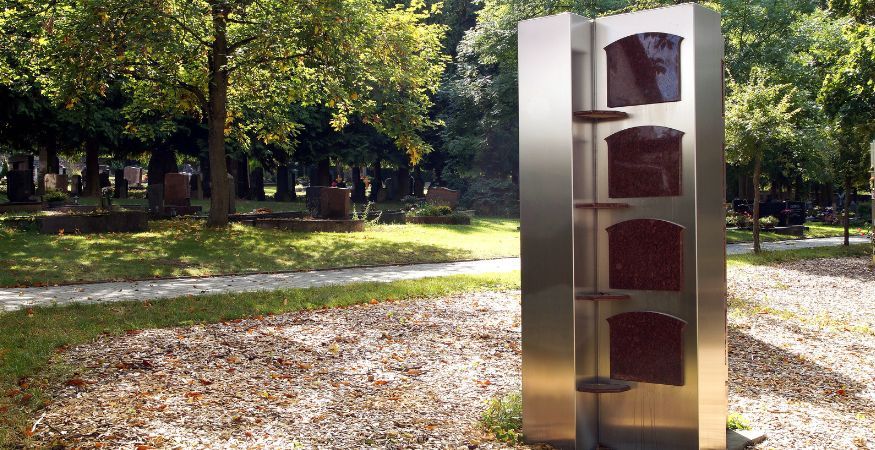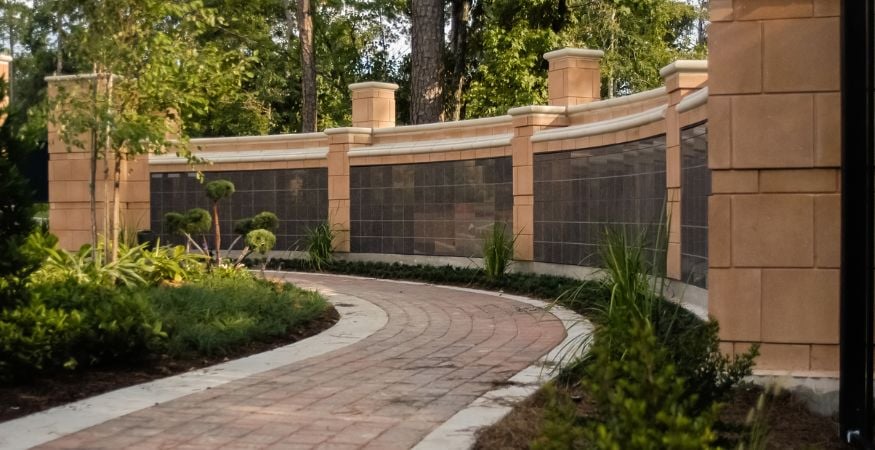| Read time: 10 mins
Cremation is on the rise, and so too, the use of columbariums and vertical structures, as consumers increasingly seek interment for cremated remains.
Skip to the end and you’ll discover an amazing new mapping and sales tool from PlotBox that will enable you to streamline columbaria and mausolea sales, but if you can wait, let’s explore why ‘finding your niche’ in this growing market is a good thing.
In this blog, we explore the rise of columbaria, why it’s happening, what the benefits are, and how you can maximise the opportunities.
Understanding Vertical Structures and Columbaria
Firstly, what are they? These structures are specially designed for the placement of cremated remains and offer an alternative to traditional ‘in-ground’ burials. They typically consist of a series of niches or compartments, which can be stacked vertically, providing a space-efficient and aesthetically pleasing option for the final resting place of cremated remains.
Vertical structures is a broader category that encompasses various designs, including columbariums, mausoleums, or even other vertical burial structures and while differing slightly in appearance and function, they all share the common feature of housing remains.
Columbariums are a specific type of vertical structure dedicated exclusively to storing and displaying cremation urns. They can be freestanding or integrated into existing structures and can vary in size, accommodating different numbers of niches.
So why are we seeing more of them?
The Rise of Vertical Structures and Columbaria
Cremation is on the rise, and we might point to this shift in funeral preferences as a driving force behind the rise, so to speak, of vertical structures and columbariums.
Learn why cremation is on the rise.
Vertical structures and columbariums are meeting changing consumer demands, and while doing so, also provide a valuable solution to the issue of space for cemeteries - especially in regions where available land for traditional in-ground burials is limited or expensive.
Let’s talk about space
Columbariums and vertical structures aren’t of course a panacea or magic bullet solution for all of the issues relating to space, land availability and sustainability, but they do provide a number of advantages in that regard over traditional burial methods:
Space Efficiency: As vertically designed structures with multiple niches for the interment of cremated remains, columbariums allow cemeteries to maximise the use of limited space. Instead of requiring large expanses of land for graves, columbariums use less ground area while offering a high capacity for urn placement.
Densely Populated Urban Areas: In densely populated urban areas where open land is scarce and valuable, columbariums offer a practical solution. Cemetery operators can make the most of the available land and meet the needs of the local community while reducing the environmental impact of larger cemeteries.
Minimal Ground Disturbance: Traditional in-ground burials require excavation, which disrupt the natural landscape and require ongoing maintenance. Columbariums, on the other hand, minimise ground disturbance - foundations and footprint etc. notwithstanding - allowing the surrounding area to remain relatively undisturbed.
Sustainable Land Use: As urban areas continue to grow, the demand for land for various purposes and using land efficiently is essential to ensure sustainability. Columbariums help to meet this need and promote sustainable land use by accommodating more interments within a smaller space.
With all of that in mind, let’s look at the benefits, more broadly, for operators and consumers.
Benefits for Cemetery Operators
For operators, columbaria present a potentially lucrative sales opportunity, making efficient use of limited space while generating significant revenue through the sale of niche spaces.
Moreover, they can help to diversify cemetery services, attracting a broader customer base that includes those who may prefer a method of interment other than traditional burial. Importantly, this diversification can also help offset declining revenue from traditional burials.
They can also, of course, enhance customer relationships. Providing a greater range of interment options allows operators to engage with families and offer them solutions tailored to their unique needs.
Benefits for Consumers
First and foremost, vertical structures provide choice. Where there is a move towards cremation, these structures facilitate that growing need, and in relation to ash interment or inurnment specifically, an alternative to traditional scatterings or bringing urns home.
In terms of personalisation, columbariums can also often provide a range of niche designs and sizes, allowing families to select one that best reflects the personality and interests of their loved ones - including customised plaques, engravings, and decorative urns.
Often set within well-maintained, tranquil areas within a cemetery or crematorium the accessibility afforded by these structures also means that those with mobility issues or those who prefer a more straightforward visitation process can easily visit the resting place of their loved ones.

Maximising the opportunity
Those wanting to capitalise on the trend of vertical structures and columbaria may want to consider a number of factors:
Strategic Location: Identify locations within the cemetery that are suitable for vertical structures, taking into account visibility, accessibility, and aesthetics - investing in well-placed structures may help to attract more families.
Variety of Options: Consider a variety of niche sizes and designs to cater to different preferences. This flexibility allows families to choose a space that best honours their loved ones.
Personalisation Services: Provide options for personalisation, such as niche plaques, urn selection, and engravings. These services can significantly enhance the overall customer experience.
Inventory Management: having clear visibility and control of your inventory provides you with total confidence in exactly what you have to sell and where, allowing you, for example, to plan out your availability by placing certain plots on hold, or making others available for sale.
Streamlined Sales Processes: It’s imperative that you have the sales processes in place to maximise the opportunity. That means having the sales tool at your disposal that will help you to provide visibility and to sell from anywhere - enabling consumers who may not be able to visit your site with a view of exactly what you have to offer. Importantly, that also means enabling them to easily find and select niches close to loved ones.
Pre-need Planning: All of which together will help to support your pre-need sales strategy and speed up the buying process.
Education, education, education
Ultimately, for columbarium or mausoleum operators, it’s all about educating consumers that they are an option that will ultimately help them to increase their uptake.
Many people may be unaware of the alternatives available, so investing in marketing methods that can help you to educate about these options and their benefits is crucial.
This education can happen at different stages of the funeral planning process:
Pre-Need Counselling: Pre-need counselling services provide the opportunity for individuals to learn about their options and make informed decisions about their final arrangements. As a proactive approach, this can help consumers to understand the many benefits.
Funeral Planning Workshops: Hosting workshops, webinars or seminars on funeral planning in partnership with local community groups can be another effective way to educate consumers. These events can cover topics like cremation, ash disposal, and inurnment options, including vertical structures.
Brochures and Online Resources: The more traditional forms of marketing can still be an effective way of educating consumers - whether that’s through information brochures and online resources that explain the benefits. Consider an online SEO campaign, providing informative content on ash interment options, and make sure your website clearly outlines the range of services you have to offer and provides opportunities to learn more.
Digital Marketing and Social Media: Leverage your social media platforms to reach a wider audience. Share informative content and updates, making sure that they’re a place for fresh and interesting content.
Personalised Guidance: And not forgetting the personal touch - when families come to make arrangements with you, be sure to provide personalised guidance about the various options available, while highlighting the advantages.
PlotBox Vertica Mapping
The funeral and cemetery industry is continually evolving, and staying ahead of trends and maximising every opportunity is essential for long-term success.
While cemetery and crematory managers continue to explore creative solutions to meet the changing needs of consumers, it's important they have the tools to support those initiatives - tools such as PlotBox Vertica Mapping.
PlotBox Vertica Mapping provides an immersive 360 degree view of both indoor and outdoor Mausolea and Columbaria. It allows you to enter a 3D view of your space, navigate corridors, and search real time inventory availability. Accessible online from anywhere on any device, it provides a view for families from the comfort of the office or in their own home, with a heat map showing real time inventory status, linked to your digital plot records.
Like to learn more about Vertica mapping? Visit our webpage and download our solution one pager for more.
